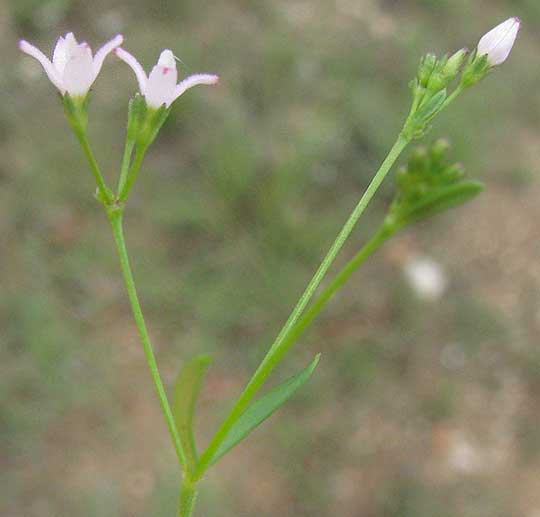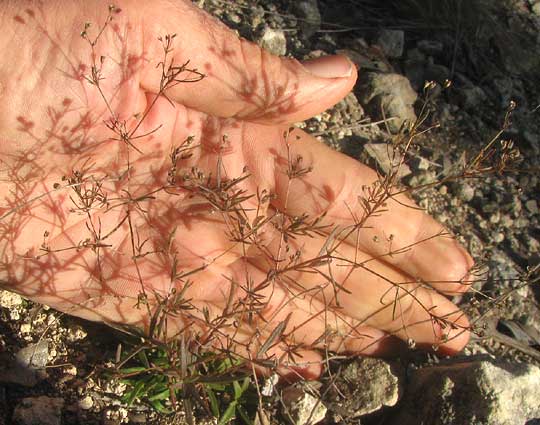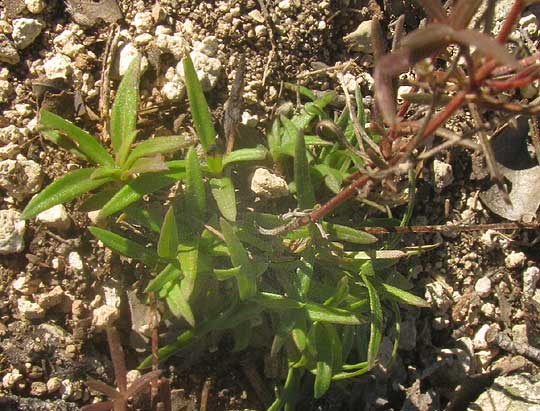Excerpts from Jim Conrad's
Naturalist Newsletter

from the June 23, 2013 Newsletter issued from the Frio Canyon Nature Education Center in the valley of the Dry Frio River in northern Uvalde County, southwestern Texas, on the southern border of the Edwards Plateau; elevation ~1750m (~5750 ft); N29.62°, W99.86°; USA
PRAIRIE BLUETS
For over a month a certain small wildflower has been producing a few pale blue blossoms about ¼th inch across (6mm). Sometimes this wildflower grows in patches and the randomly spaced blossoms diffused through the grass are reminiscent of stars in the sky. You can see such an effect above. Below, notice how the flowers' four corolla lobes curl back revealing hairy inner faces:

Wildflower lovers in eastern North America will recognize these as Bluets, and assume that they're members of the genus Houstonia, of the mostly tropical Madder or Coffee Family, the Rubiaceae. That's what I thought, but I wasn't quite right. Commonly our Texas plants are indeed referred to as Bluets, but our plants are perennials with woody bases, while the East's Bluets are herbaceous annuals. As such, our Bluets are placed in a different genus.
Our woody-based perennials are STENARIA NIGRICANS, usually called Prairie Bluets, Diamondflowers, Narrowleaf Bluets, Baby's Breath, Fine-leaf Bluets, or just plain Bluets. Some wildflower books place it in the genus Hedyotis. In fact, the species has been shifted among several genera.
Prairie Bluets occur mostly in the US south-central states and sporadically farther east, into arid northeastern Mexico. The species specializes in occupying sandy or limestone-derived, dry, rocky prairies and hillsides, rocky, open woods, and roadsides. Our plants seldom grow over about a foot high but I read that in rainier areas they reach three times that, and such big plants in full flower must be awfully pretty.
from the December 22, 2013 Newsletter issued from the Frio Canyon Nature Education Center in the valley of the Dry Frio River in northern Uvalde County, southwestern Texas, on the southern border of the Edwards Plateau; elevation ~1750m (~5750 ft); N29.62°, W99.86°; USA
PRAIRIE BLUETS IN WINTER
Now the Prairie Bluets' flowers have long fallen away and the herbage that's so green and lush in the picture has acquired a purplish cast from the frost, and tiny capsular fruits are split open distributing their seeds whenever the plant is hit or shaken by the wind. Below, you can see a plant in its winter condition:

A close-up of some capsules -- the one at top, right not yet open but two others already open and releasing their seeds -- appears below:

That picture shows that the capsules split along sutures crossing the fruits' tops. Also, the unopened capsule displays short, slender sepals arising from its midsection. From this we determine that the fruit is "inferior," the term used for flowers in which stamens and sepals do not arise below the ovary, but rather above the ovary's base. The capsule with its elevated sepals is what became of the inferior ovary. This makes sense because bluets are members of the Coffee or Gardenia Family, the Rubiaceae, which in a world where most flowers are "superior" produces "inferior" ones.
Elsewhere in North America bluet species are found looking very much like this, except they are annual members of the genus Houstonia, not perennial members of the genus Stenaria, like ours. Below, you can see our Prairie Bluets' springy-looking rosettes of next season's leaves arising from a woody base, with this season's purplish, dying-back stems rising above them, and even traces of last year's decaying stems on the ground:
